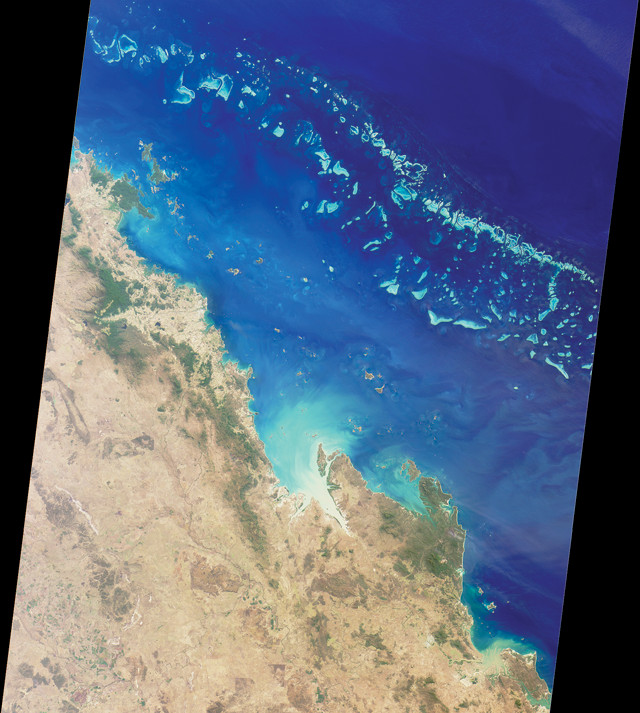
by Rachel Crowell Friday, August 3, 2018

The Great Barrier Reef has rebounded from die-off events many times; however, it has never faced the combination of threats that it does today. Credit: NASA.
It’s hard to imagine Earth without the Great Barrier Reef, yet with the threats confronting it — including ocean warming and acidification — its demise is a possibility marine scientists are studying. A new study of how sea-level rise and sedimentation have impacted the reef over the last 30,000 years, however, shows it might be more resilient than previously thought.
Jody Webster, a marine geologist at the University of Sydney in Australia, and colleagues report in Nature Geoscience that the reef has rebounded multiple times in the wake of die-off events.
The team cored into fossil portions of the Great Barrier Reef and conducted sedimentological, biological and geochronological analyses to assess “the impacts of abrupt sea-level and associated environmental changes,” the researchers wrote.
The cores were collected from 20 boreholes at 16 different sites off the coast of Mackay and Cairns in Queensland, Australia. In total, the team dated more than 580 samples of coral and coralline algae to produce the first continuous record of the Great Barrier Reef’s evolution over its lifespan.
The oldest fossil reef sample, which was collected from a site called Noggin Pass near Cairns, indicates that the first iteration of the reef was exposed and died about 30,000 years ago as sea level began to drop heading into the last ice age.
A second iteration, constituting a “very narrow and ephemeral fringing reef system,” existed from 27,000 to 22,000 years ago, but was killed by rapid sea-level fall and exposure as the ice reached its maximum extent in this part of the world. Vertical accretion, or growth, of this reef was slow — just 0.3 to 2.5 millimeters each year — possibly resulting from restricted available space or higher local sedimentation during its lifetime. The depth of the water in which the reef was growing plummeted to less than 10 meters before this portion of the reef perished, according to the team’s analysis of coral-algae samples.
Between 21,000 and 17,000 years ago, sea-level rise resulting from early deglaciation spurred reef development with rapid yearly vertical accretion rates of 3.9 to 4.4 millimeters. About 16,000 years ago, however, “an increased flux of fine terrigenous sediments … may have reduced light availability and water quality,” Webster and her team wrote. That, combined with rapidly rising sea levels, drowned the reef. The last reef die-off was due to similar causes and occurred about 10,200 years ago.
“This is a very interesting, detailed reconstruction of coral reef response — for example, growth rate and community structure — to Earth’s last major period of climate disruption during the ice age and subsequent deglaciation,” says Kenneth Rubin, a geochemist and volcanologist at the University of Hawaii at Manoa, who wasn’t involved with the research. “It provides clues as to how coral reefs respond to environmental change.”
Today’s Great Barrier Reef began growing about 9,000 years ago. While it faces sea-level rise and other threats from which previous incarnations of the reef bounced back, today’s threats are occurring more widely, at the same time and at a faster pace, the authors note.
“The outlook is still likely bleak in the short term (10 to 50 years), if we continue to see year-on-year coral bleaching and other pressures,” Webster says.
With additional pressures from sea-surface temperature increases of 0.7 degrees Celsius per century and “sharp declines in coral coverage … our new findings provide little evidence for resilience of the Great Barrier Reef over the next few decades,” the researchers wrote.
Study co-author Donald Potts, a coral reef ecologist at the University of California, Santa Cruz, says the reef may disappear for a few human generations, but says it’s likely the reef “will [eventually] re-establish and recover.”
© 2008-2021. All rights reserved. Any copying, redistribution or retransmission of any of the contents of this service without the expressed written permission of the American Geosciences Institute is expressly prohibited. Click here for all copyright requests.